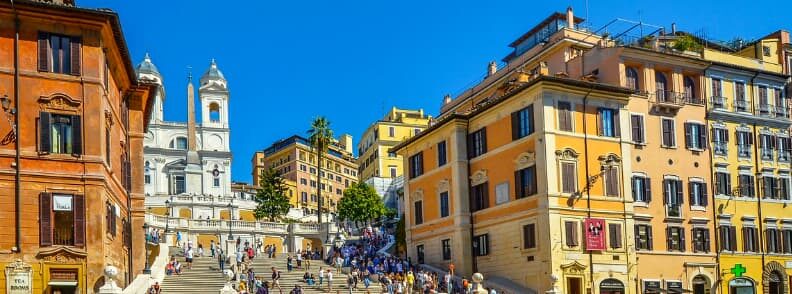Rome is a city that is abundant in culture and history, and its lovely piazzas are the ideal expression of this lively ambiance. Each square, from the famous Piazza di Spagna to the quaint Piazza di San Silvestro, has its own special charm and personality. Rome piazzas must be explored, whether you’re a history enthusiast, a culture vulture, or just a traveler hoping to get a feel for the real Rome. Join us as we explore the wonders of Rome’s beautiful squares and learn why they play such a significant role in the city’s rich history.
We began our morning away from the center of the Italian Capital. We took the subway to Piazza del Popolo, where we wanted to enjoy our breakfast while admiring the twin basilicas and doing some people-watching.
Piazza del Popolo
Having breakfast in Piazza del Popolo was a bad decision. We left the terrace of Canova starving: we waited a long time, yet nobody came to take our order. So we went across the piazza, to Rosati. Here, we managed to eat. But we spent 30 euros on a small breakfast. At the place we went to the days before, breakfast went up to around 8 euros, coffee included.
But I guess when you’re going to a terrace in one of Rome’s piazzas, you’re mostly going there for the place. Since the request is high, it also makes sense that the prices are high, as well.

Luckily, the beautiful things we got to see in the area and the other Rome piazzas we covered along the way quickly made us forget about the less-than-perfect beginning of the day!
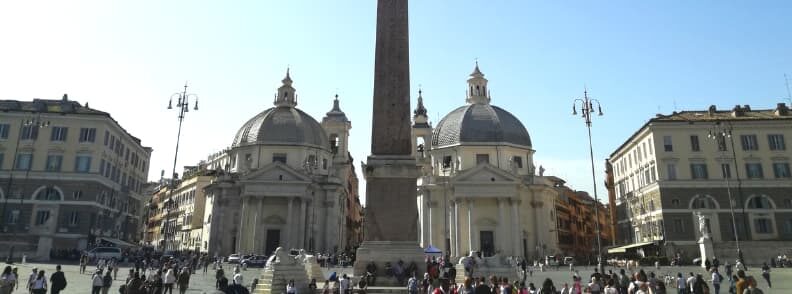
The basilicas in Piazza del Popolo
As you enter the Piazza by Porta del Popolo, you see a church on your left: Basilica Parrochialle Santa Maria del Popolo. Unfortunately, when we visited Rome, this basilica was under restoration, so we skipped it. Therefore, we missed Caravaggio’s Crucifixion of Saint Peter and the Conversion of Saint Paul.
From the Porta del Popolo, if you look ahead, you can see Rome’s Piazza del Popolo in perfect symmetry: you have the twin white basilicas in the background, separated by the obelisk in the middle of the circus. Aligned with the obelisk, you can see Fontana del Nettuno on the right, and Fontana della Dea di Roma on the left.
The twin basilicas are Santa Maria in Montesanto and Santa Maria dei Miracoli. Though always treated together, Santa Maria in Montesanto is a minor basilica, unlike its twin. It is also Rome’s Church of the Artists. Anyway, they’re quite a sight. You won’t see something similar in other Rome piazzas.
We saw the interior of the two basilicas briefly and quietly. We visited on a Sunday and there were religious ceremonies taking place. This is also why we don’t have any photos of their interior from this trip.

Terrazza del Pincio
After crossing Rome on foot from Vatican City to Trastevere, then wandering the streets of Rome’s historic center for a day, you’d expect us to be too tired for some climbing. But it would have been a pity to get to Piazza del Popolo and not go up a few stairs to Terrazza del Pincio.
Terrazza del Pincio offers one of the best views over Rome’s historic center and the surrounding piazzas from its perch atop Pincian Hill, which overlooks the city. Tourists and locals alike use this terrace to take amazing photos and relax in its cafés, restaurants, and gardens.
From the Terrazza del Pincio you can enjoy one of the best views over Piazza del Popolo and the rest of Rome. It’s a great place to admire the Eternal City, in its entirety. And off we went to explore more piazzas in Rome!
The Trident
Once you get back down in the Piazza del Popolo, you are at the base of a trident. It is formed by three of Rome’s most important avenues: Via di Ripetta, Via del Corso, and Via del Babuino. If you look at the map, you will see that the avenues composing the trident are actually very long. On a closer look, you’ll notice that Via di Ripetta and Via del Babuino continue with other streets. But Via del Corso continues all the way to Piazza Venezia. And this is impressive, considering the length and width of this avenue right from the start. Just compare it to all the narrow, winding, little streets on its sides and you’ll get the picture!
Anyway, it’s the best place to start to see the most important piazzas in Rome. We chose to continue on Via del Babuino, to end up on Via Margutta.
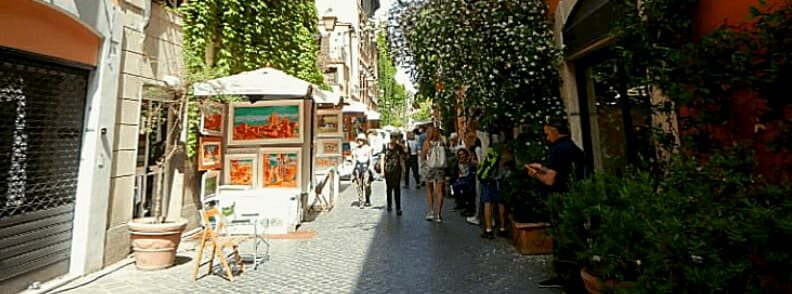
Via Margutta
This short street, covered in cobblestone and with lovely luscious green ivy covering its buildings, welcomed us with charming artist stands. This came as no surprise, as Via Margutta has always been where the artists chose to live, transforming it into a true art hub.
If you wish to see how the street looked in the past, you should watch the movie Roman Holiday, with Audrey Hepburn and Gregory Peck. You’ll not only see some of the best sights in Rome, as they were in the ’50s, but you’ll also recognize Via Margutta as the place where Gregory Peck’s character lives.
The other end of Via Margutta takes you back to Via del Babuino. Continue on this street and you’ll end up in Piazza di Spagna. This is one of the most famous Rome piazzas!
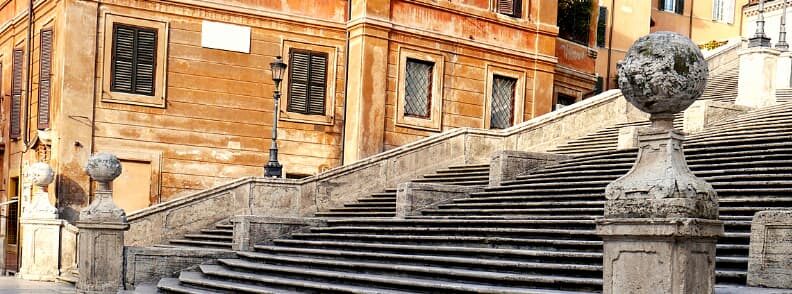
Spanish Steps (Piazza di Spagna)
We should have started our day earlier. When we arrived in Piazza di Spagna, it was already full of tourists. But this is something one should expect since Piazza di Spagna is one of the most famous places in the Eternal City, therefore it has a higher number of visitors when compared to other Rome piazzas.
As Mathieu likes big crowds even less than I do, I quickly showed him the Spanish Steps, with Obelisco Sallustiano and Trinita dei Monti at the top, and Fontana della Barcaccia at the base.
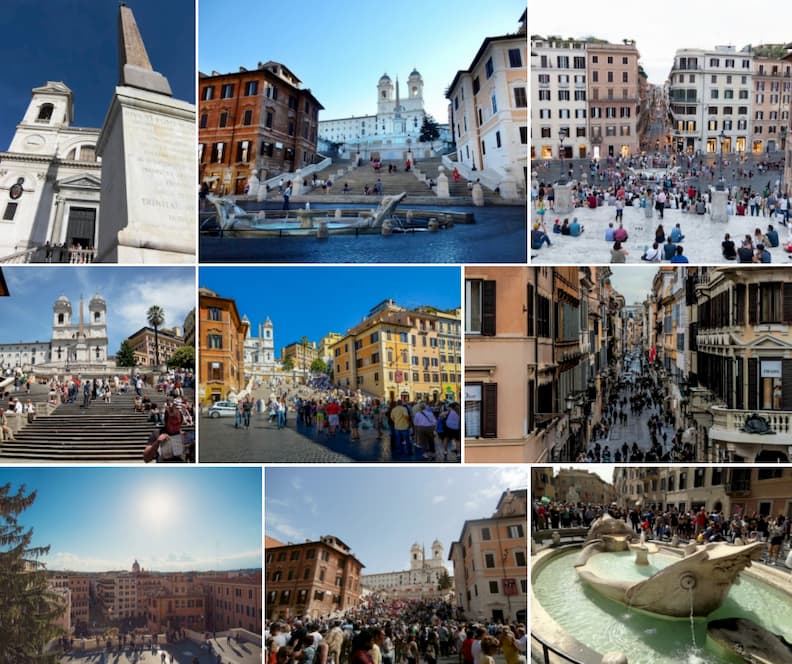
Being in such a hurry left me a bit disappointed for not spending more time to discover Obelisco Sallustiano and Trinita dei Monti, especially since on my previous trip this was under restoration. The day we chose for seeing this part of Rome was also unfortunate because the Keats-Shelley Memorial House was closed. Then again, this holiday was for Mathieu, and out of the two of us, I would have been the only one interested in visiting the Keats Shelley House.
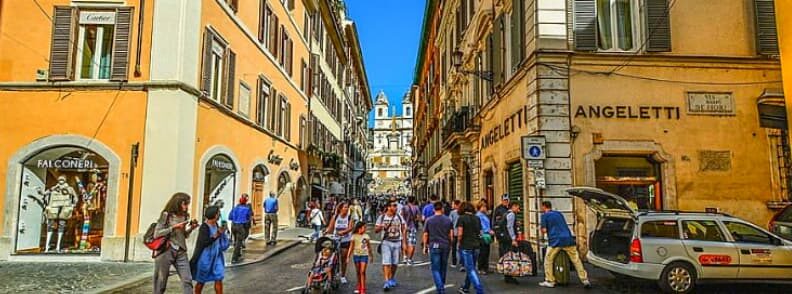
So we cut short and saw the Column of the Immaculate Conception in the nearby Piazza Mignanelli, and also quickly showed him Via Condotti, full of people. While I may understand the numbers of people in Piazza di Spagna, I had difficulty empathizing with those on Via Condotti who were just slowly advancing in crowds on the street without going into any of the shops.
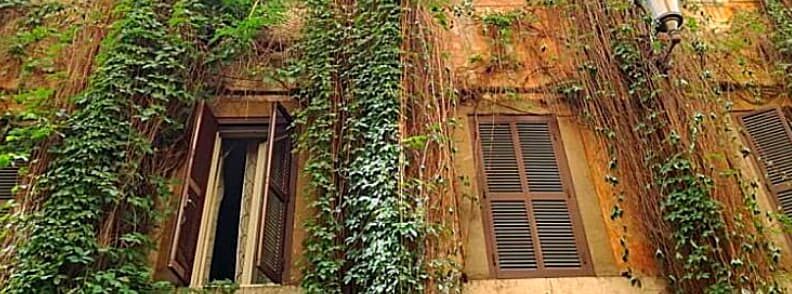
The parallel street, Via Borgogna, was almost empty and quite nice, so we found it perfect to continue our walk to Via del Corso. Rome piazzas may be beautiful, but sometimes they pale in front of the incredible streets of the Eternal City.
Mausoleo di Augusto
From Via del Corso, we went to Via dei Pontefici to reach the ancient tomb known as Mausoleum of Augustus, or Mausoleo di Augusto, in Italian. The first Roman Emperor, Augustus, and his family were buried here when it was built, in 28 BC.
One of Rome’s oldest and most well-known structures, the mausoleum is a massive elliptical building made of brick and concrete that is embellished with carvings and inscriptions. One of the most spectacular tombs in the world, it’s regarded as a significant example of Roman engineering and construction. Although very old, the site is still in very good condition.
Unfortunately for us, it was under restoration. So we gave it a look from a distance, then headed down on Via di Ripetta, on the Tiber’s western shore. It was still hot outside, so we found our short break by the Fontana del Pianto to be quite refreshing. After that, we wandered around to find a nice place to eat something small and fast.
I can’t find the name of the place, though, and Google Maps isn’t really helping. I found the table we sat at on the map, but I can’t find the front entrance. Google Maps is only showing fancy restaurants there and this was a small place, like a cafe with two tables out back and a couple of tables inside. Anyway, the place was charming, and the building across the street from the table was impressive.
After finishing our paninis, we took Via Tomacelli back to Via del Corso.

Piazza di San Silvestro
Crossing Via del Corso took us to Piazza di San Silvestro. Here, we came across a lovely church, Chiesa San Silvestro in Capite. Its courtyard is absolutely amazing!
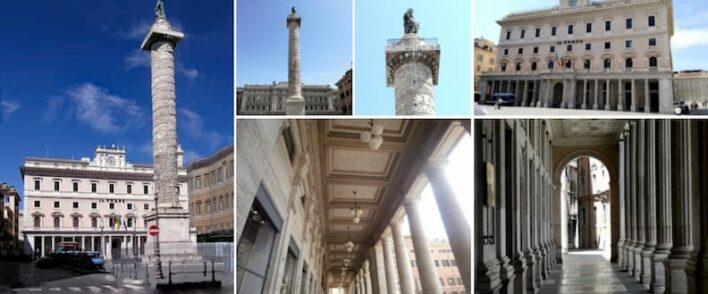
Piazza Colonna
Via del Corso took us to Piazza Colonna, a square featuring Palazzo Chigi, Palazzo Wedekind, and the imposing Column of Marcus Aurelius. The latter is also behind the name of this piazza in Rome.
Colonna di Marco Aurelio is a Roman victory column modeled after Trajan’s Column. The marble column is adorned with reliefs showing the emperor’s military conquests in the Danube area.
The Column of Marcus Aurelius remained on this spot since AD 193, and it used to have a statue of the Emperor on the top. In 1589, however, Pope Sixtus V ordered the statue to be replaced with the one of Saint Paul, which we can still see to this day.
In this Rome piazza, you can also admire some other columns: those of the 16th-century Palazzo Chigi, the home of the Prime Minister. This Italian palace is a significant example of Renaissance architecture and it is famous for its lovely courtyard, which is decorated with murals by Raphael. The Palazzo Chigi is not accessible to the general public but it can be admired from the outside.
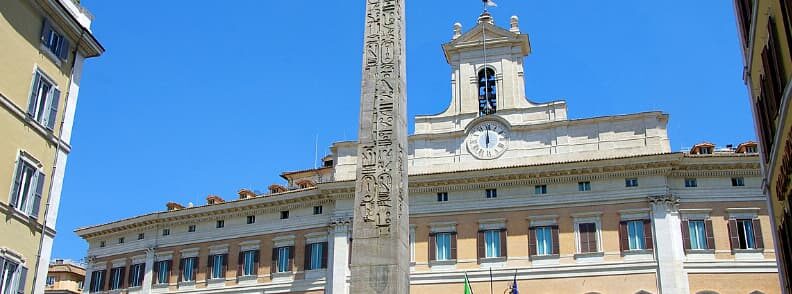
Piazza di Montecitorio
Take just a few steps away from Piazza Colonna, and you’ll find yourself in Piazza di Montecitorio. Here, you can admire the impressive baroque-style Palazzo Montecitorio, built by Bernini in 1653. It now houses Italy’s Camera dei Deputati (Chamber of Duty), which is why protests and other political gatherings frequently take place in this Rome piazza.
In front of it, at some distance, you can see Obelisco di Montecitorio, an ancient, red-granite Egyptian obelisk. It is also known as Solare.

Piazza di Pietra
This area has a high concentration of Rome piazzas! Walking South from Piazza di Monte Citorio, you’ll discover Piazza di Pietra. Here, you will see a temple built in the year 145 AD, which was later incorporated into a different building. (It is done in a similar fashion as Teatro Marcello, seen on our first day in Rome.)
The old part of the building is the Temple of Hadrian, raised by Antoninus Pius, Hadrian’s adoptive son and successor.
What I really liked in Piazza di Pietra, however, was the yellow, stained building, next to Hadrian’s temple. You know what they say: to each his own! And this is one of the Rome piazzas with a bit for everyone’s tastes.
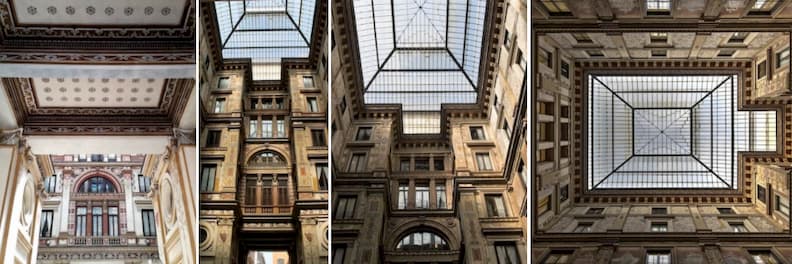
Galleria Sciarra
Crossing again Via del Corso, if you go on Via Marco Minghetti, you can take a glimpse of one of Rome’s hidden gems. Galleria Sciarra was built in the late 19th century, in an art nouveau style and it’s amazing!
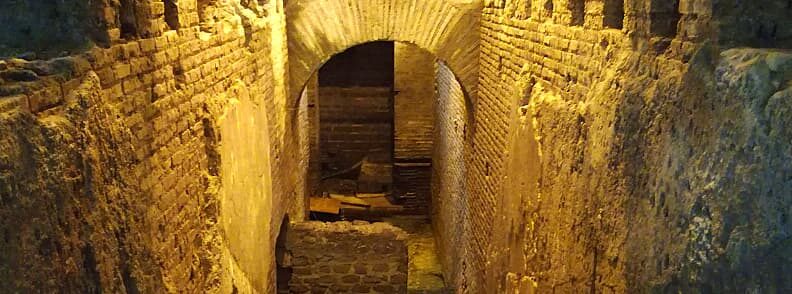
Vicus Caprarius – The Water City
After feasting your eyes on this, you can drop by Fontana di Trevi again, if seeing it the day before wasn’t enough for you. Or, you can walk straight on Vicolo dei Modelli, then on Vicolo del Puttarello. These two, narrow, charming streets will take you to Vicus Caprarius – The Water City.
The small, yet stunning archaeological area is under a small cinema. It’s not only a very interesting visit but also a great shelter from the heat in the middle of the day!

Le Quattro Fontane
After visiting Vicus Caprarius, we decided to move away from the center. We passed Palazzo del Quirinale (the Presidential Palace) on Via del Quirinale and reached its beautiful intersection with Via delle Quattro Fontane. Here, on each side, you can see a late Renaissance fountain. There is one representing the Tiber in Rome, and one of the Arno rivers from Florence. The other two are representations of the Goddess Juno, symbolizing strength, and the Goddess Diana, symbolizing chastity.
Next to Le Quattro Fontane, there is also the church San Carlo delle Quattro Fontane.
We continued walking until we were near Termini. We stopped to have a well-deserved glass of red wine at Gran Caffè del Passeggero, before visiting Palazzo Massimo alle Terme.
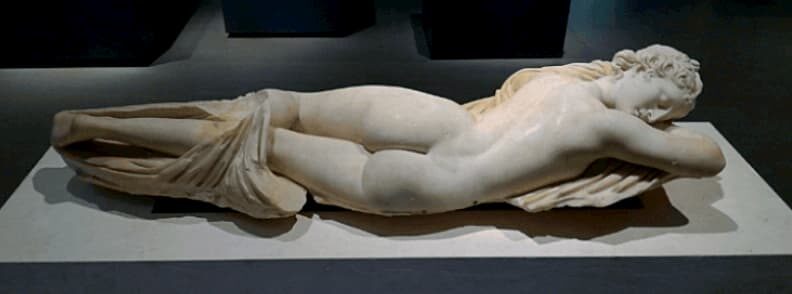
Palazzo Massimo alle Terme
As we really enjoyed our visit to Palazzo Altemps and we still had a valid ticket for the National Roman Museums, we went to Palazzo Massimo alle Terme. Its four levels offer a good insight into Roman art. The basement houses a collection of jewels, grave ornaments, and Roman coins. On the ground floor and on the first floor you will find Roman and Greek statues and sculptures. Last, but not least, on the second floor, you will discover the best-preserved Roman frescoes in the world.
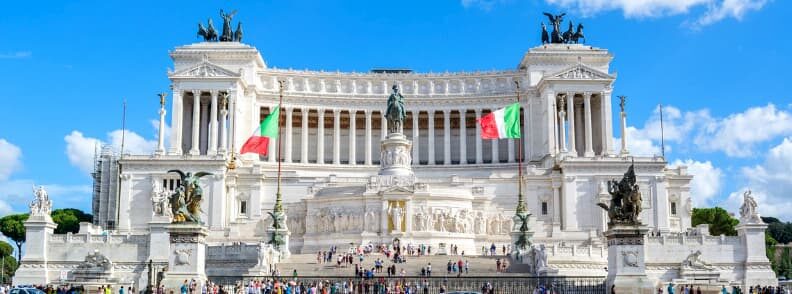
Piazza Venezia
In the evening, we were back in Piazza Venezia, in search of a cozy place to have a good dinner. Wandering around, we stumbled upon Il Buco. It was a family-owned place, with a very small terrace.
While waiting for our food, we heard the people from the table next to us telling their friends they found this place when they first arrived in Rome, and they liked it so much that they returned there every evening. Once we tasted the pasta, we understood why. It was delicious!
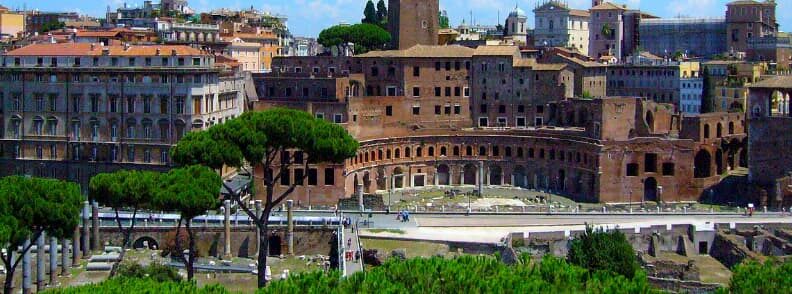
Piazza Foro Traiano
After dinner, we took a short walk to the last of Rome’s piazzas for the day: Piazza Foro Traiano. Here, we admired Trajan’s Column, Foro di Cesare, and Trajan’s Forum, from afar.
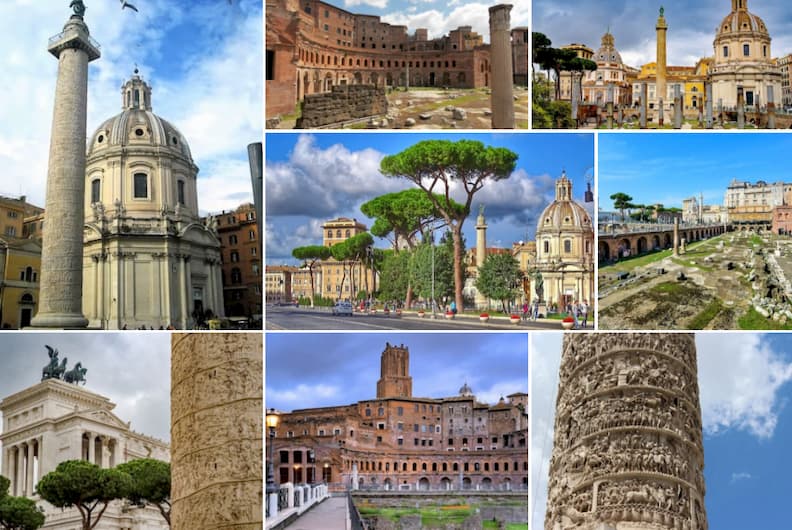
An unforgettable day exploring beautiful piazzas in Rome
After exploring Rome’s picturesque piazzas for a whole day, it’s obvious that these lively squares are an essential component of the city’s rich history and culture. There are several intriguing things to see and do, and each piazza has its own charm and personality. The many piazzas of Rome have something for every traveler, from the famous Piazza di Spagna to the lovely Piazza Colonna.
There is no shortage of wonderful sights and experiences to be had in Rome, whether you’re appreciating the Palazzo Chigi’s architecture, wandering around the Terrazza del Corso, or just taking in the ambiance of one of the city’s many other attractive squares.
So, in the end…
What is the most famous piazza in Rome?
Piazza di Spagna, located at the base of the Spanish Steps, is arguably Rome’s most famous square. Fontana della Barcaccia, the piazza’s stunning fountain, is well-known for its aesthetic appeal and lively environment, which frequently features street performers and vendors. The Spanish Embassy and the Church of the Trinità dei Monti are also in this Rome piazza
This article is also available on GPSmyCity.

Mirela Letailleur is a Romanian travel blogger living in the South of France. She writes on The Travel Bunny travel blog about affordable travel in Europe, creator of unique free travel guides, local travel expert. Problem solver. Wannabe coffee guru.
More to see after uncovering the most famous Rome piazzas
Colosseum, Roman Forum & Palatine Hill
Walking from Vatican City to Trastevere
More of Rome’s historical center

